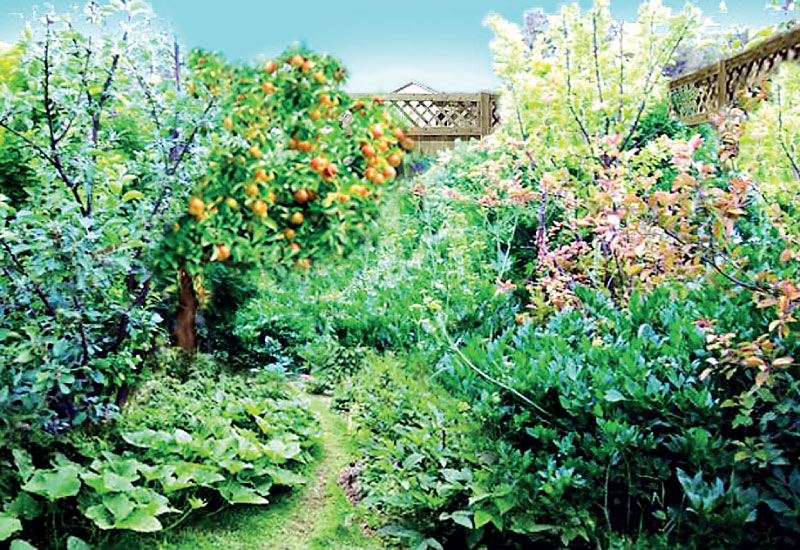Tuesday Dec 23, 2025
Tuesday Dec 23, 2025
Saturday, 27 November 2021 02:36 - - {{hitsCtrl.values.hits}}

Water and soil are the twin flames of abundance and fertility of nature and the rewards of having a forest garden is that you realise that all sorts of animals live around you – birds that chirp and call which are happy with the lustre of living
|
 By Ranjit Seneviratne
By Ranjit Seneviratne
Harvesting rain water by flooding is an ancient practice done by Sri Lankan kings, landscaping the land to collect water into our famous ‘Tanks’ (man-made lakes). This was done to prevent Soil Erosion by flowing water, which removes precious top soil, bird and insect droppings, twigs and leaves washed down from the trees.
Flooding ensured more water seeped into the soil and to the water table and these two factors increased the depth and richness of the biomass of soil micro-biota, worms and insects, which in turn, nourished plants and trees, birds and animals and us.
Harvesting rain water from the roof
The method used in our dry zones is to collect roof rain water into large tanks. This can be done in Colombo or anywhere too, by leading the roof gutter down pipes into normal plastic water storage tanks. These tanks should be placed on a brick or other structure so as to be high enough above ground, so water can flow down a hose pipe to water the garden, without the need of a pump.
Since the gutter down pipes are bigger than the standard overflow pipe at the top of the tanks, it would be necessary to cut a hole and fit a larger pipe as the overflow pipe. To prevent mosquito breeding, fit a cover with a mesh (brass or stainless steel). As dirt from the roof will collect in the tanks, it is necessary to drain the tanks periodically, to flush out dirt from the bottom of the tank.
If there are trees or if leaves collect in the gutters, then it would be necessary to cover the gutters with half-inch plastic-coated wire mesh. It would be wise also to make a ‘Leaf Trap’ for the tank. This is easily done by cutting a hole in the water tank cover and putting in a 1-gallon plastic bucket so that about half of the bucket sticks out above the tank cover.
Cut a hole in the bucket, a little bigger than the diameter of the gutter down pipe, and put in a brass or stainless-steel mosquito mesh into the bottom of the bucket. The leaves will collect in the bucket and can be periodically cleaned out. The mesh will also keep out mosquitoes (I have done this for my tanks).
To prevent mosquito breeding in gutters, drill 1 mm holes at locations where water collects, to drain this water. To prevent splashing by falling water, make it flow down a stainless steel or brass wire or nylon fishing line (thangus) kept in place by tying a brass screw at each end, one to keep it place in the gutter and the other buried in the soil or in a flower pot.
Harvesting rain water that falls in the garden
Make sure water does not run immediately into drains, by having the drain ‘lip’ about 1 or 2 inches above ground level, so rain water will flood for about 1 or 2 inches, before flowing into the drain.
In order to keep the drive-way dry and usable, it would need to be about 1 1/2 to 2 inches above the level of the garden. Similarly, paths around the house or back yard would need flat stones or concrete paving blocks placed so that they are 1 1/2 or 2 inches above ground level.
For houses without drains around the house, landscape the garden around the house, with a positive slope for about 3 or 4 feet or more from the foundation to the level of the garden. The level of the garden should preferably be 4 to 6 inches below the level of the bottom of the house or foundation, to keep out water from the foundation area. As in the case above, make sure there is a 1 to 2 inch flooding of the property by raising a barrier to the water flow going out of the garden.
2 inch flooding: Will it affect the foundation of a house?
According to people in house construction, houses are designed to be at least 1 foot above ground level to allow a maximum flood of 12 inches. So, a 2 inch flood would not have any adverse effects.
Excessive flooding
If the property is prone to excessive flooding, then it would be necessary to make a ‘Soakage Pit’ by digging a pit say 3 by 3 ft or 4 by 4 ft by 6 or 8 ft deep, filling the bottom with large stones and then progressively smaller stones and finally covering it with sand. This makes a kind of shortcut for water to quickly reach the water table. However, in houses built on marshy land that has been filled with soil, “Soakage Pits” may not work as the water table could be rather high.
Rain water harvesting on land with a slope
This is done by terracing the land at suitable intervals along parts that are at the same level or “contour” and putting in place “Erosion Barriers” – short bunds or walls (of cement or normal bricks) that are say, 1 or 2 inches higher than the land.
Water will collect and flood up to 2 inches in the area behind the bund and the overflow would go to the next level and so on until finally the water could drain into a pond or a Soakage Pit. These barriers should be gracefully curved or ‘S’ shaped along the contour to look more natural and graceful and curves also add strength to the barrier wall.
Importance of having a pond as a water feature
Having a pond at the lowest level would be a natural choice, but the reasons for having ponds are many, from providing a water source for birds and insects (very necessary for butterflies) to using it for home cooling, by having a small pump make a waterfall down a rock feature built against a house wall that gets a lot of sun.
Evaporating water from the rock feature cools the rocks and therefore the walls – a sort of natural air-conditioning. Having Guppy fish that eat mosquito larvae makes it anti-dengue mosquito. Dragonflies are also attracted to ponds and their grubs feed on mosquito larvae. Frogs and toads also feed on flying insects (I have three ponds, two or wall cooling).
Once you have a system to save the rainwater, you might as well start a forest garden
In order to have a ‘Forest Garden’, you need to start with saving rainwater and leaves and twigs from big trees, similar to what is found in a forest. This is because most soils have been stripped of minerals by repeated conventional farming (much taken out and very little put back in) and about 40 years of chemical agriculture. Hence the need to use leaves and twigs of deep-rooted trees to heal the soil, as the soil deep underground should still have good mineral content
How to make a speeded-up composter for leaf composting, instead of a compost bin or pit
Leaves, twigs on the forest floor compost rapidly as there is plenty of oxygen. But compost bins and pits need turning over and take weeks, even months to compost, because of a lack of oxygen or air. A simple solution – make circular composter 3 or 4 ft diameter, using plastic covered small mesh netting, with a larger mesh bottom to allow worms enter the composter and a cover to keep out rain from wetting it too much and draining the soil-like structure made by the worms etc.
For a bigger, rectangular compost bin with provision for tapping “wormy wash”, have a slightly sloping concrete base that would drip “wormy wash” into a plastic gutter with a half inch hole at one end to collect “wormy wash” into a bucket buried in the soil. The sides of the bin are made with plastic-coated small mesh netting with poles (or pipes) at the four corners for support and a roof over the bin and collector to keep out excess water, but with sufficient space between bin sides and roof for good access.
Leaves and twigs are placed in the bin and regularly watered with a light spray and covered with a plastic sheet to keep it moist. The “Starter” of worms and micro-biota is made by burying peeled bananas about half inch in the soil.
Depending on worm density in the soil, there would be plenty of worms feeding around the bananas the following morning. Carefully pick up the worms and bananas with a generous amount of soil and place it deep inside the mass of leaves and twigs. The bin should be regularly watered to keep it moist and never allowed to dry out
Note: “Wormy wash” is rather strong and should be diluted if used to fertilise potted plants.
Collecting necessary inputs for healing the soil: ‘Bio Char’ charcoal
In ‘Heal the soil’ gardening/farming, it would be wise to use ‘Bio Char’ charcoal – made by burning thicker branches in a metal drum about 2 ft diameter and about 2 ft high (such drums available along Central Road, Pettah). Wait until all the wood is burning well, then cover the top of the drum to minimise air/oxygen, so that the fire would go out, but the wood would continue to burn and finally become charcoal.
Research has shown that ‘Bio Char’ provides very large surface areas for microbes, which helps enrich soil micro-biota. The charcoal should be broken up into smaller pieces (not powdered) and mixed into the mulch or soil. Even better is ‘Activated Charcoal’ from coconut shell available at the ‘Good Market’ shop. Large logs too big for burning should be buried about 2 ft deep underground, as they would be a long-term resource for the soil biota.
Planting of fruit and berry trees
If the garden is small it would be necessary to plant grafted Fruit and Berry trees, such as Star Fruit, Nam nam (Cynometra cauliflora), Ambarella/June Plum (dwarf type), Jak, Citrus trees (Pomello, Grape fruit, Lemons, Limes).
Rose apple (Jambu), Lovi-lovi, Java plum (Madhang) as well as Banana and Papaya (avoid seedless and Genetically Modified [GMO] varieties) as research shows they interfere with natural body processes (even birds do not eat them). Please search out indigenous fruit varieties (Deshiya Beeja). Not only search them out and plant them, but also re-plant and foster them carefully so that you could encourage others also to conserve the indigenous food varieties of Sri Lanka.
Plant vines along the boundary walls by erecting wire netting as a climbing frame
If you have bare walls, erect an inner fence of wire-netting as a climbing frame for vines, such as Passion Fruit, Green and Red Spinach, Kiri Aguna, Kuringnang herb, Elephant foot yam (Engili Ala), Purple yam (Rathu/Raja ala) – these not only produce large Yams below ground, but also potato-like Ala on the vine (like fruits) and these can be cooked like potatoes or even eaten raw.
Planting of increasingly rare medicinal herbs and beneficial insect attracting local plants
To most people vegetables means Carrots, Cabbages, Beets, Leeks – all introduced by the Colonials. But what did we eat before these were introduced?
Today they are called “Medicinal Herbs” such as Gendha (Portulaca) high in vitamin E – grows by the roadside even today), “weeds” such as Kuppamenia (Acalypha indica) an expectorant to treat Asthma and Pneumonia and for skin problems, Polpala (Aerva lanata) dissolves bladder and kidney stones, Mukunuwenna (Sessile joyweed) cures Piles, Jaundice, Infertility, prevents cancer, various types of Thampala, (Amaranth) ayurvedic usage (treatment for EcZema, Piles, Gonorrhoea), Gotukola (Centella asiatica) for heart and stress problems, brain health, Sarana (Horse Purslane) Asthma, Diabetes, Maduruthala (Holy Basil) strengthens immunity against viruses, Nidhikumba root - Stomach worms, dysentry, Lunuwila (Bacopa) strengthens brain function and other common weed type plants – Gus Nivithi, Ambul Ambili, Monara Kudumbi and a whole lot more.
Maintenance
New applications of wood chips are only required to keep the layers preferably a minimum of 4 inches deep, because the lowest layer of wood chip mulch becomes compost/top-soil. The protective top layers dry out in the sun, but absorbs water at night, thus keeping the compost/top soil moist.
The ‘Heal the soil’ process of building a layer of top soil takes time, about 10 months for a layer of about 3 inches in sandy soil and perhaps longer in soil that is hard and mixed with clay.
The roots of the plants spread widely in this layer of top soil, because it is so soft and also allows the roots to collect moisture from a wider area and yams to grow huge. The top soil thus gradually increases in depth so that plants become more and more luxuriant and productive over time. When plants are so full of moisture they are optimally healthy and therefore more resistant to pests.
Growing a mix of plants (as in a forest) especially with insect-repelling plants like Holy Basil, Neem (Kohomba) and plants with strong scented leaves also discourages insect pests. Note “yellowing” of leaves indicate a lack of Magnesium and Dolomite or “Magsulph” may be needed.
Weeds do not take root because of the dry wood chip covering. Any weeds that do grow are easily pulled out – root and all because, the top soil is so soft and moist.
Pest control is automatic as there is a balance of pests and predators, but natural pest control methods may be needed for infestations by introduced species like “Piti Makuna” – boil a mix of Neem/Kohomba and Citronella/Pangiri leaves and when cool spray on affected plants. For fruit flies and mosquitoes – rub grease on a yellow plastic sheet, paste pieces of Pineapple and Banana and the yellow colour and smell of ripe fruit will attract them and they get stuck to the grease.
Flooding by heavy rain would also be much reduced, because the layer of top soil (depending on the thickness) is very absorbent and any excess water quickly vanishes into the soil.
 Rewards of rainwater harvesting and having a forest garden around your home
Rewards of rainwater harvesting and having a forest garden around your home
You will never know how rewarding it is to revel in the knowledge of our ancient type of village rainwater harvesting (which is as simple as digging smallest size water ‘tanks’) and allowing water to hold within them. The mud becomes a wall like entity after sometime and the water clears up.
In ancient Lanka, villagers cared for not only themselves but also animals and these ‘tanks’ provided much needed water for animals and lasted for quite some time thwarting the parching of the earth and its inhabitants. A few fish would often than not surface in these tanks which would prevent mosquito breeding.
Water and soil are the twin flames of abundance and fertility of nature and the rewards of having a forest garden is that you realise that all sorts of animals live around you – birds that chirp and call which are happy with the lustre of living.
Bees and beetles that chirp (raahaiya) sound at night, Butterflies, Grasshoppers, Dragonflies, Fireflies and with them small animals – lizards, frogs and squirrels – you actually have a mini-jungle.
Another realisation is that there is communication going on within nature. Scientists have found that trees communicate using funghi that form networks of fungal “theads” (mycelia) around plant roots. They have been found to share nutrients with smaller daughter plants and those receiving less sunlight. They even produce chemicals that fight insects and send warnings to neighbouring trees.
|
(The writer is a marine engineer by profession. He was Project Operations Officer, FAO, Rome and one of his projects dubbed ‘Blue Revolution’ by the locals resulted in the Government of Bangladesh, winning the first Souma Award, given by FAO to a Government that best developed an FAO project. His FAO Project in Eritrea was shortlisted for the second Souma Award and two of his Project Managers won B.R. Sen Awards for Excellence. He is currently a soil healing consultant who maintains his Colombo home garden as a laboratory to develop various techniques of biodiversity conservation that includes rainwater harvesting.)